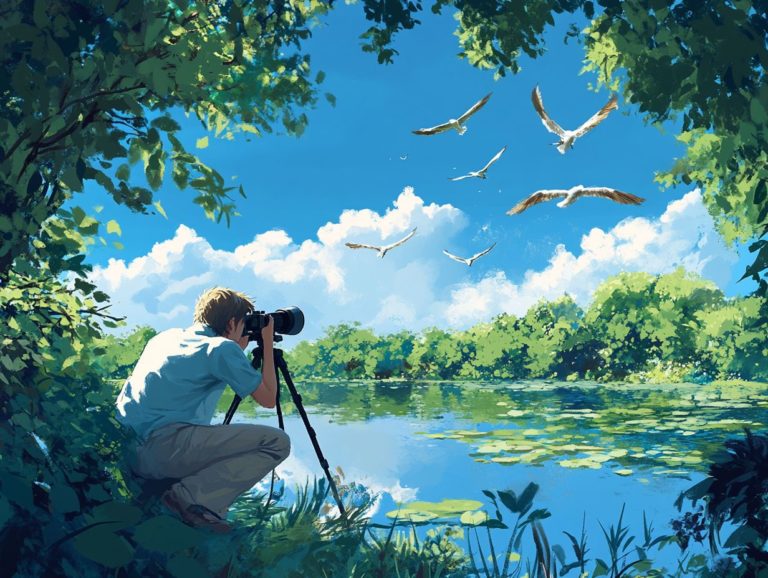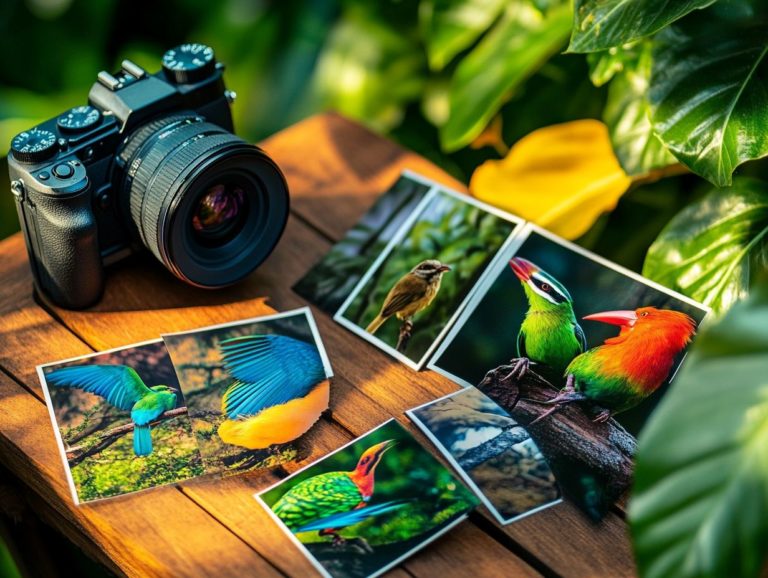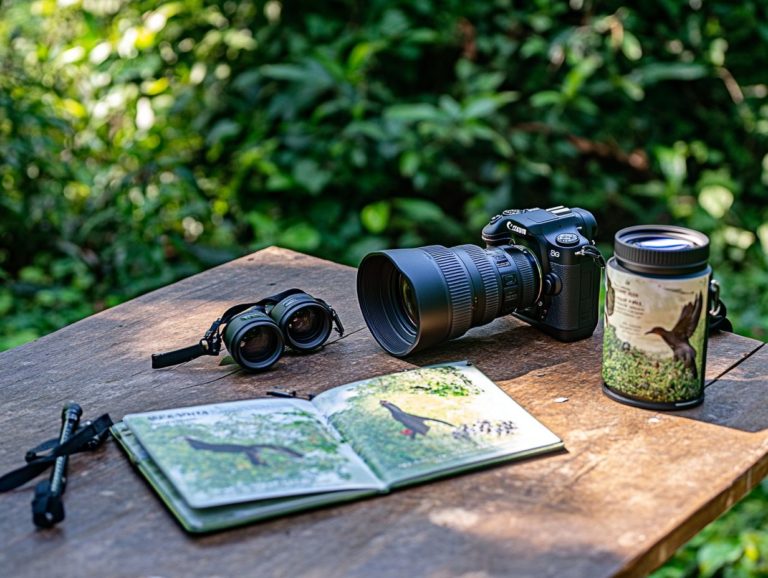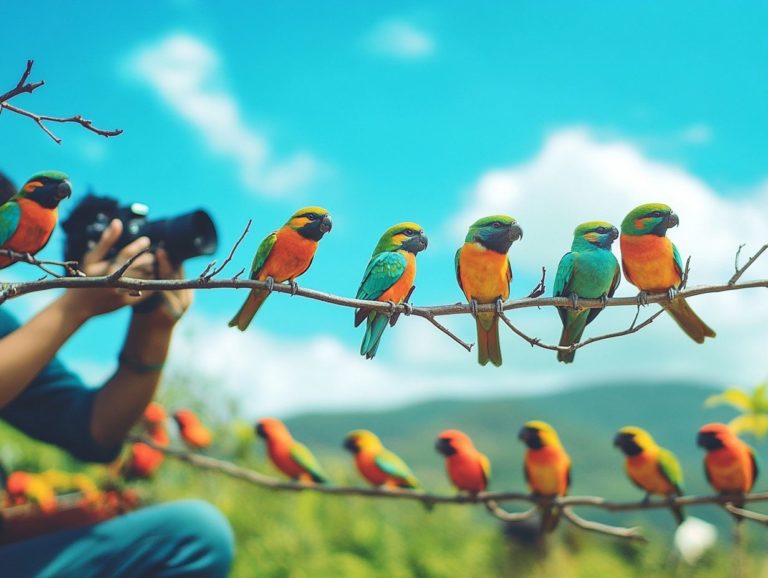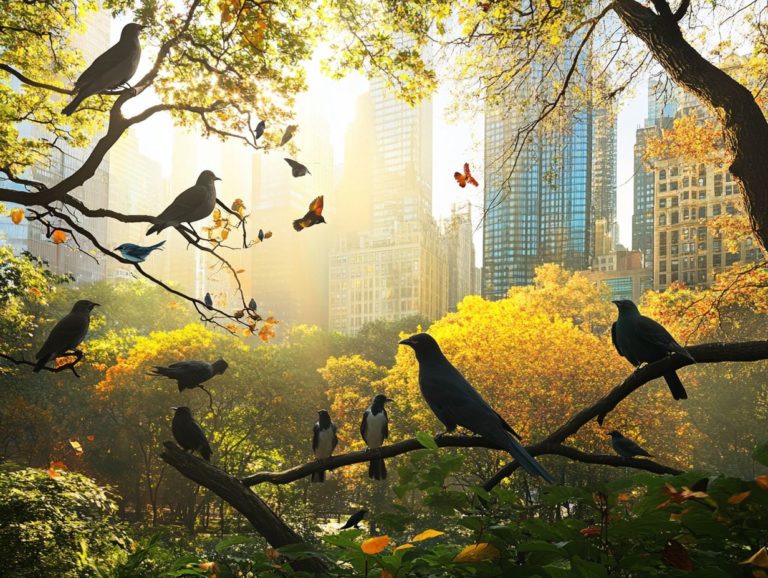Exploring Wildlife Photography Ethics
Wildlife photography provides a remarkable glimpse into the beauty of nature. However, it also carries a profound responsibility.
As a photographer, your choices can leave a lasting imprint on the animals and environments you wish to capture, particularly for sensitive species. This article delves into the significance of ethical wildlife photography, emphasizing responsible practices for engaging with animals.
It addresses common ethical dilemmas and offers techniques for capturing striking images while respecting the subjects, including understanding animal behavior. Seize the chance to lead the way in ethical photography!
Contents
- Key Takeaways:
- The Importance of Ethical Wildlife Photography
- Responsible Practices for Wildlife Photographers
- Common Ethical Issues in Wildlife Photography
- How to Capture Ethical Wildlife Photos
- Promoting Ethical Wildlife Photography
- Frequently Asked Questions
- What is wildlife photography ethics?
- Why is it important to follow ethical guidelines when photographing wildlife?
- What are some examples of unethical practices in wildlife photography?
- How can I ensure that my wildlife photography is ethical?
- What are the consequences of not following wildlife photography ethics?
- Are there any benefits to practicing ethical wildlife photography?
Key Takeaways:
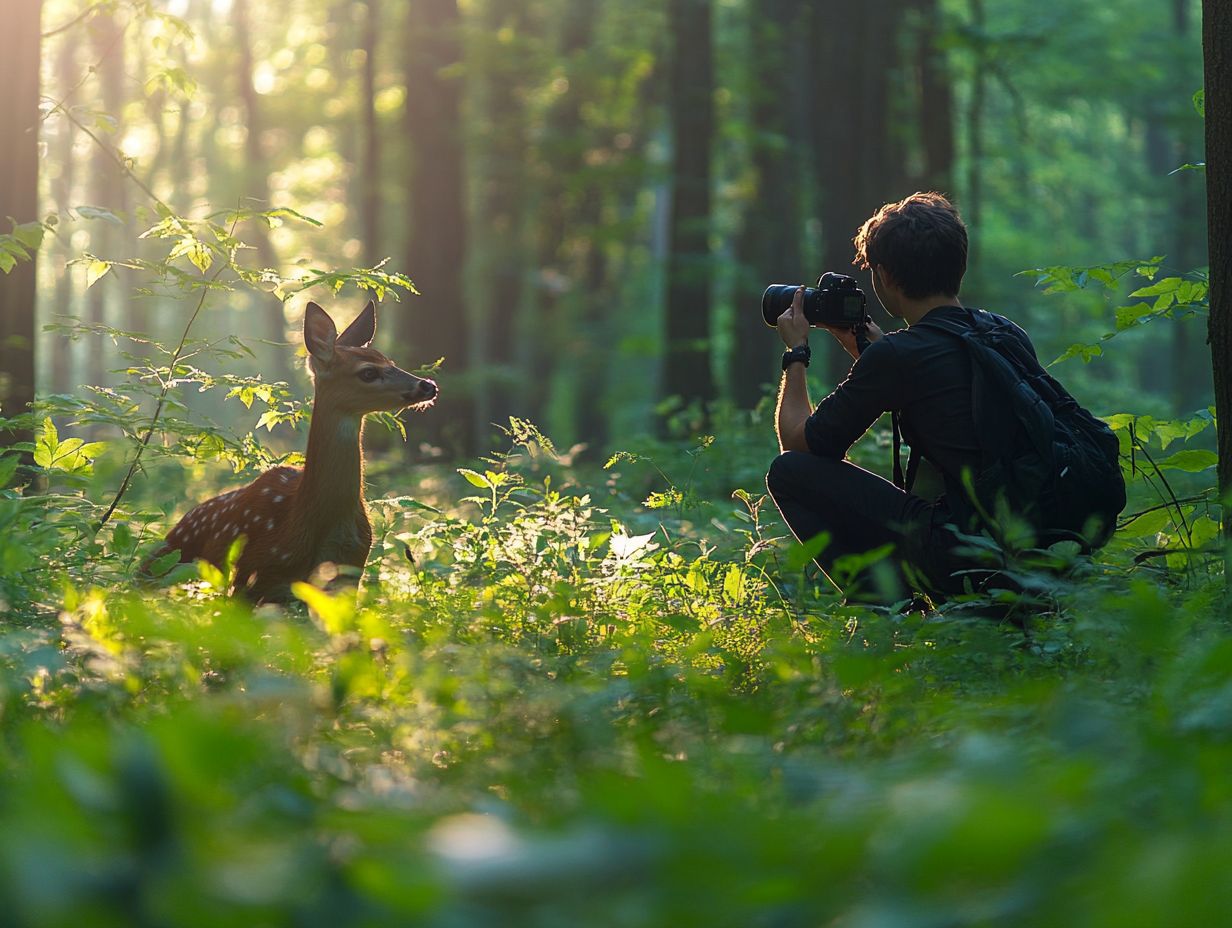
- Ethics are crucial in wildlife photography to protect animals and their habitats, preventing harm and exploitation.
- Responsible practices, such as following guidelines for interacting with animals and protecting the environment, are essential for ethically capturing wildlife photos.
- Techniques for capturing natural and respectful images can ensure ethical wildlife photography. Promoting ethical practices encourages others to do the same.
The Importance of Ethical Wildlife Photography
Ethical wildlife photography is essential for promoting wildlife conservation and nurturing a deep respect for natural habitats. It enables you to capture breathtaking images while prioritizing the well-being of sensitive species.
By embracing ethical photography, you document the splendor of wildlife and illuminate the environmental consequences of our choices. Photographers such as Gil Wizen and Carlton Ward Jr. serve as prime examples of how responsible practices significantly contribute to the protection of endangered species.
For every wildlife enthusiast, considering ethics is not just important; it is imperative.
Why Ethics Matter in Wildlife Photography
Ethics in wildlife photography are vital your choices can protect animals and their habitats. They play a direct role in the welfare of wildlife and the conservation of sensitive species within their natural habitats.
The choices you make in the field can have significant repercussions, not just for the subjects you capture but also for the ecosystems these animals inhabit. You often find yourself balancing securing that perfect shot and respecting the natural behaviors of wildlife.
A conservation photographer faced backlash for disturbing a leopard’s den, causing the mother to abandon her cubs. This incident sparked a broader conversation within the photography community about balancing artistic endeavors and responsible practices.
By prioritizing respect for animal behavior and employing techniques that minimize intrusion, you can play a vital role in wildlife conservation and foster a more harmonious relationship between your art and the natural world.
Responsible Practices for Wildlife Photographers
Embracing responsible practices is crucial for wildlife photographers, as it allows you to capture breathtaking images while ensuring the welfare of the animals and protecting sensitive species from harm.
Your commitment to ethical photography not only enhances the quality of your work but also contributes to the preservation of the natural world.
Guidelines for Interacting with Animals
To maintain wildlife welfare, you must adhere to specific guidelines when interacting with animals. Utilize equipment like a telephoto lens which allows you to take close-up images from a distance to capture images from a safe distance.
This approach elevates the quality of your images while minimizing stress on the subjects. By taking the time to observe animal behavior, you can gain valuable insights into when it s appropriate to capture images without causing disturbance.
Keeping a respectful distance is crucial; getting too close can provoke unpredictable reactions from wildlife, endangering both the animals and yourself. Be mindful of your surroundings and avoid disruptive actions, such as loud noises or sudden movements, that could startle the animals.
Ultimately, ethical photography involves understanding these dynamics and using the right equipment, like camera traps and a telephoto lens, to ensure respectful and safe encounters in nature.
Join us in protecting wildlife by practicing ethical photography!
Protecting the Environment and Wildlife
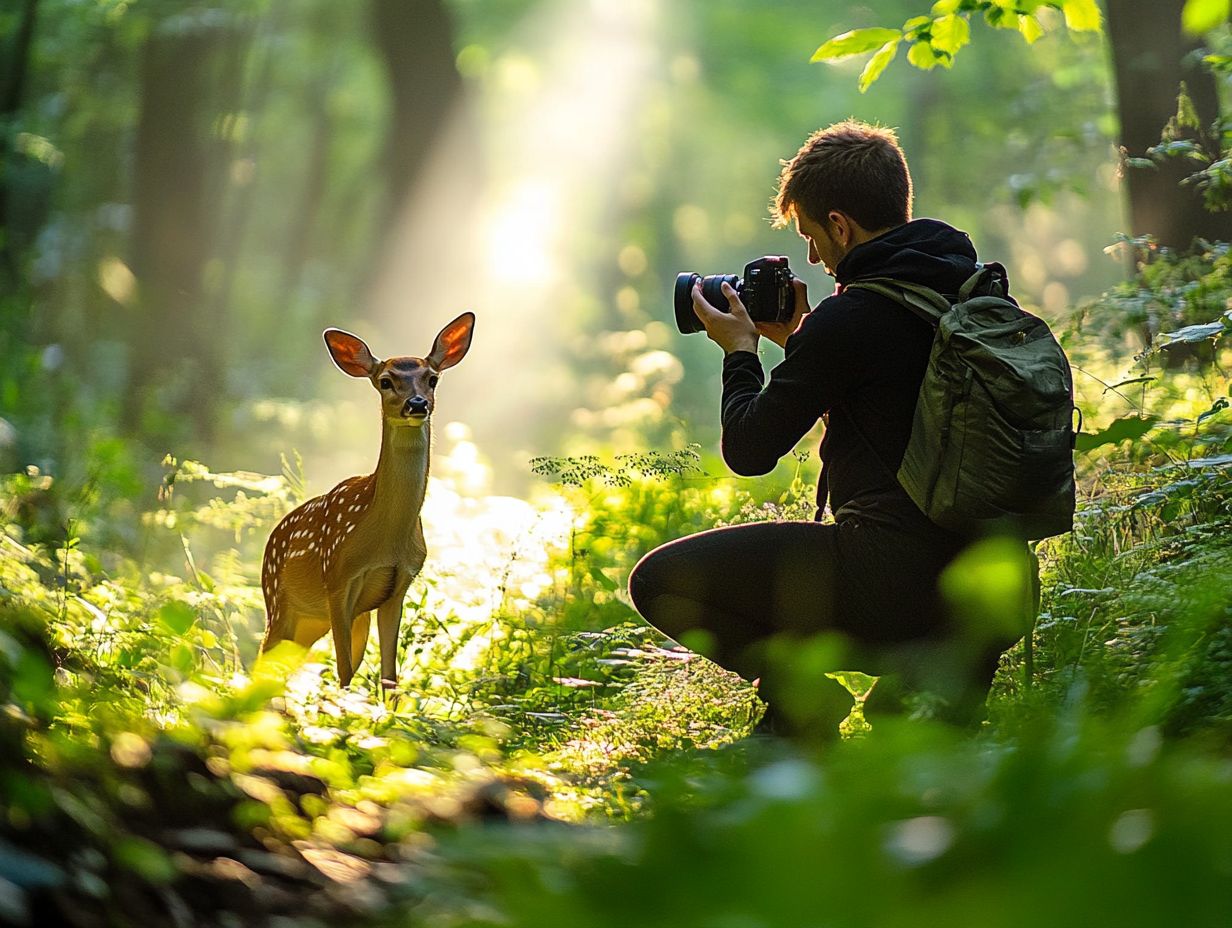
Protecting the environment and wildlife is paramount for you as a photographer. You must consider the environmental impact of your actions while showcasing the beauty of endangered species.
By capturing stunning images that highlight the fragility of natural habitats, you have the power to be a wildlife conservation advocate your photos can spark change! Your art can evoke emotions and provoke thought, inspiring viewers to take action and support initiatives aimed at protecting these vital ecosystems.
To amplify your message, collaborate with wildlife sanctuaries by participating in awareness campaigns or donating a portion of your sales to conservation efforts. Share the stories behind your photographs on social media to elevate the urgency of preservation and encourage meaningful discussions about the importance of maintaining natural habitats for future generations.
Common Ethical Issues in Wildlife Photography
You will encounter various ethical dilemmas in wildlife photography, particularly when capturing images that may impact animal welfare and disrupt natural habitats. For beginners, understanding wildlife photography tips is essential, as your choices can have a big impact, making it crucial to navigate these challenges thoughtfully.
Disturbing or Manipulating Animals for Photos
Disturbing or manipulating animals just to snag captivating photos raises significant ethical concerns and can seriously harm wildlife welfare. These actions can inflict immediate stress on animals and disrupt their natural behaviors, nesting patterns, and even mating rituals.
For example, when photographers intrude on a nesting bird’s personal space, they might inadvertently cause the parent to abandon its young, leading to dire consequences for the chicks. As a photographer, it’s crucial to embrace your responsibility and prioritize wildlife well-being over the pursuit of the perfect shot.
Countless documented instances show that crossing boundaries harms populations, like the disruption of sea turtle nesting sites by eager photographers trying to capture the moment, often resulting in disturbed nests and reduced hatchling survival rates.
Deception and Misrepresentation of Images
Deception and misrepresentation in wildlife photography can seriously undermine your credibility and create ethical dilemmas that jeopardize wildlife welfare and conservation efforts. This critical aspect emphasizes the responsibility you hold in accurately representing wildlife and their habitats.
When you engage in image manipulation whether through misleading editing or staging scenes it can distort public perception, leading to misguided conservation practices. Transparency is essential; your audience deserves to understand the context behind the images to foster a genuine appreciation for the natural world.
By adhering to ethical guidelines and showcasing authentic moments, you can maintain your integrity and play a pivotal role in raising awareness and protecting the species you document.
How to Capture Ethical Wildlife Photos
Capturing ethical wildlife photos requires you to adopt specific techniques that prioritize animal welfare while still achieving breathtaking visuals. You ll often find yourself utilizing advanced tools such as camera traps automatic cameras that capture wildlife photos without human presence and drone photography, which uses drones to take aerial images.
By using these methods, you can create impressive images that respect the natural world.
Techniques for Capturing Natural and Respectful Images
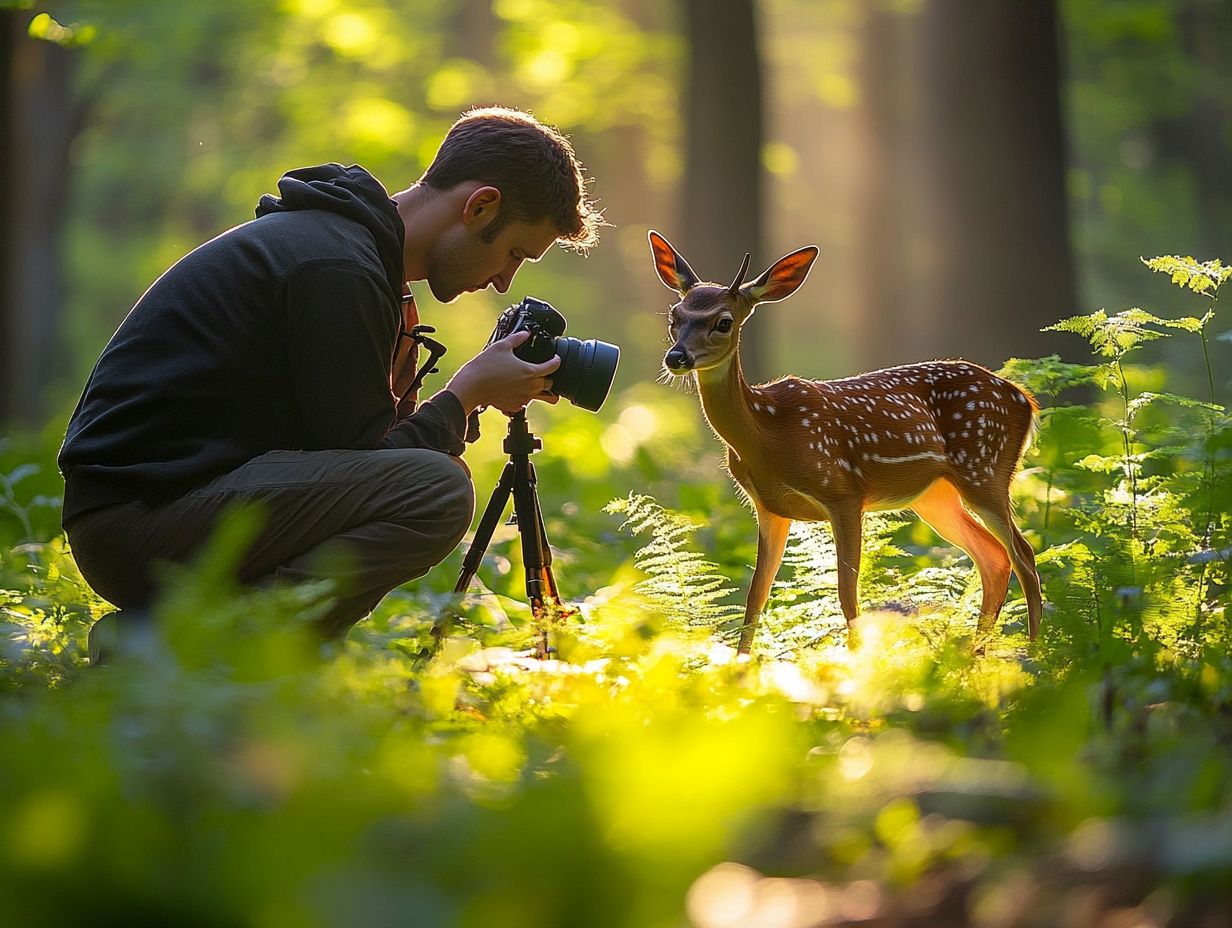
Using techniques that promote natural and respectful imagery is essential for you as a wildlife photographer committed to ethical practices.
By adopting methods such as using a telephoto lens a type of camera lens that allows you to zoom in from a distance you can keep a safe distance from your subjects. This allows you to capture stunning details without causing unnecessary distress to the animals. Such an approach not only highlights genuine behaviors but also reduces the risk of disturbing their habitats.
Using low-light techniques can enhance your visuals by effectively utilizing natural light, helping you avoid the startling effects of flash photography on wildlife. Practicing patience and keen observation of your environment enables you to anticipate moments, resulting in compelling images that authentically depict the wild while prioritizing the well-being of its inhabitants.
Promoting Ethical Wildlife Photography
Promoting ethical wildlife photography requires you to inspire fellow wildlife enthusiasts and photographers to embrace responsible practices. By sharing your commitment to wildlife welfare, you can lead by example, fostering a community dedicated to protecting the natural world while capturing its beauty.
Encouraging Others to Practice Ethical Photography
Encouraging others to embrace ethical photography can profoundly influence wildlife conservation efforts, cultivating a community of wildlife enthusiasts committed to safeguarding natural habitats.
This movement thrives through various initiatives, including outreach programs designed to educate aspiring photographers on the importance of respecting wildlife and their environments. Collaborating with respected wildlife sanctuaries provides powerful platforms for you to learn from seasoned conservationists while actively engaging in ethical practices, including the use of camera traps and drone photography.
By leveraging social media campaigns, you can spread awareness far and wide, showcasing success stories that inspire collective action. These efforts not only demonstrate the advantages of responsible wildlife photography but also highlight the transformative impact that a unified community can have on conservation goals, particularly in the protection of endangered species and sensitive species.
Frequently Asked Questions
What is wildlife photography ethics?
Wildlife photography ethics means understanding how to take pictures without harming animals.
It involves grasping the ethical issues surrounding the capture of images of species and ensuring that practices do not harm wildlife welfare.
Why is it important to follow ethical guidelines when photographing wildlife?
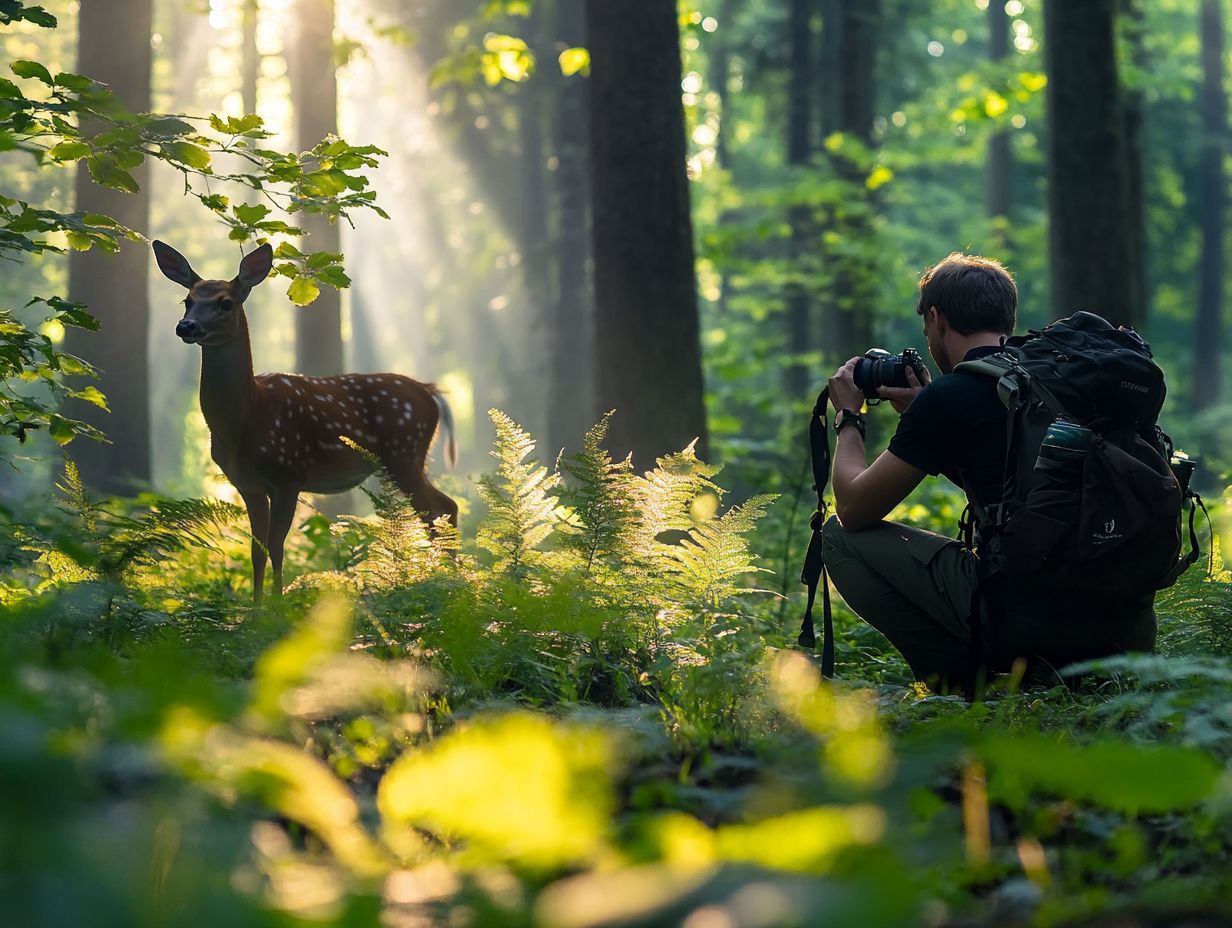
Following ethical guidelines keeps animals safe, preserves their habitats, and promotes responsible and sustainable practices in wildlife photography.
What are some examples of unethical practices in wildlife photography?
Some examples of unethical practices in wildlife photography include:
- Disrupting animals’ natural behaviors.
- Baiting or luring animals for a photo opportunity.
- Getting too close to animals for a shot.
- Using flash photography, which can startle or harm animals, especially nesting birds and rare organisms.
Join the movement to protect wildlife today! Share your own responsible photography experiences and inspire others to do the same.
How can I ensure that my wildlife photography is ethical?
Prioritize the well-being and safety of animals. Do thorough research on their behaviors and habitats.
Respect the rules of the area to avoid disturbing wildlife. Never alter their natural behaviors just for a photo.
What are the consequences of not following wildlife photography ethics?
Ignoring ethics can harm both animals and your reputation. It may lead to legal issues and damage the habitats you love.
Are there any benefits to practicing ethical wildlife photography?
Absolutely! Ethical photography promotes conservation and creates more authentic images.
This practice fosters a deeper appreciation of wildlife and sets a positive example for others.


